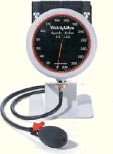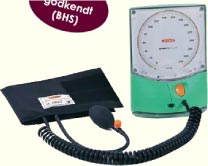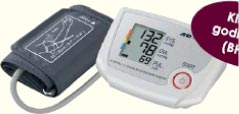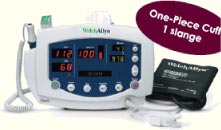|
Alternatives to mercury-containing measuring devices 5 Blood pressure measuring devices
5.1 Application of mercury-containing blood pressure measuring devicesTwo types of mercury-containing devices are used for measuring of blood pressure: mercury sphygmomanometers and mercury stain gauges. Sphygmomanometers Mercury sphygmomanometers have been used for more than 100 years and are still considered the "gold standard" of blood pressure measurements. Strain gauges Mercury consumption in Denmark According to suppliers of equipment for blood pressure measurement in the hospital sector a few mercury-containing sphygmomanometers are still sold, mainly to cardiovascular departments (Bickley 2006, Hansen 2006a). For most applications within the sector, advanced electronic equipment for automatic reading and data logging is applied. However, manual sphygmomanometers may e.g. still be used for routine measurements of patients with a weak or irregular pulse. Some general medical practitioners still request mercury sphygmomanometers. Based on information from suppliers for this sector (Skibild 2006, Christensen 2006, Hansen 2006b), it is estimated that mercury sphygmomanometers account for 5-15% of the blood pressure measuring equipment sold for this sector. The total annual consumption in 2004 is estimated at the same level as in 2001, about 170-400 pieces, corresponding to 12-28 kg Hg/year . Within the last years the consumption has decreased, because some suppliers have ceased the marketing of mercury sphygmomanometers under the assumption that the marketing of the equipment was banned. For private households, the market is totally dominated by electronic devices. A significant part of the electronic sphygmomanometers sold to general medical practitioners is actually lent to the patients for blood pressure monitoring in their homes. The mercury consumption with strain gauges in Denmark has not been investigated. It is estimated by Kemi & Miljø Konsulenterne AB (2005) that no more than 200 strain gauge tubes are needed annually for the whole of Sweden. Assuming a similar per capita consumption this corresponds to about 100 strain gauges for Denmark. Advantages and drawbacks of mercury sphygmomanometers The main drawback of the mercury sphygmomanometers, which is the main reason for their replacement in the hospital sector and the main reason for their continued phase out in other sectors, is that they are not suitable for automatic measurements. Further, the hazardous mercury may be spread to the surroundings by breakage of the manometer. In spite of the accuracy of the manometer, blood pressure measurements with manual equipment are not necessarily reproducible, because many other factors influence the measurements. In the most recent guidelines on diagnostic blood pressure measurements, the Danish Hypertension Society (Dansk Hypertensionsselskab) conclude that it is now documented that both 24-hours measurements and blood pressure measurements at home are more reproducible and predict cardiovascular events more exactly than blood pressure measurements in the clinic (Bang et al. 2006). At the same time the guidelines recommend that only automatic devices are used for 24-hours measurements and blood pressure measurements at home. It is also concluded that aneroid manometers traditionally have been considered somewhat imprecise with a tendency to calibration drift. But today the modern devices, if maintained regularly, are as good as the mercury sphygmomanometers (Bang et al. 2006). 5.2 Alternatives for main application areasAlternatives to mercury-containing sphygmomanometers on the market can roughly be divided into the following groups:
Alternatives to mercury strain gauges have not been investigated in this study, but reference is made to the description in the Swedish study undertaken by Kemi & Miljø Konsulenterne AB (2005). Aneroid sphygmomanometers for manual reading Aneroid sphygmomanometer has previously been considered less accurate than mercury sphygmomanometer in practical use. As quoted above, the Danish Hypertension Society concludes in their latest guidelines that the modern devices, if maintained regularly, are as good as the mercury sphygmomanometers (Bang et al. 2006). A drawback has been that the manometers were susceptible to bumps. Different designs are available today, and recently the manufacturer Welch Allyn have introduced a new concept (DuraShock)for an aneroid sphygmomanometer that are more shock resistant than a conventional aneroid sphygmomanometer (Galligan et al. 2003). These types are marketed in Denmark with 5-10 years calibration guarantee by several suppliers (e.g. Kivex 2006) . The example below shows a traditional type of aneroid mechanical sphygmomanometers that have been validated, meting the criteria of the BHS protocol of the British Hypertension Society (BHS 2006).
A new type of aneroid sphygmomanometers marketed as alternative to mercury sphygmomanometers, e.g. as reference manometer, is shown in the example below. The device combines an electronic manometer with a dial for manual reading. The device carries out an auto calibration to zero each time it is switched on and meets the criteria of the International Protocol for blood pressure measuring devices in adults (BHS 2006). The sphygmomanometer is sold to general medical practitioners for use as reference instrument and clinical use.
The manual aneroid sphygmomanometers are widely sold in Denmark for applications by general medical practitioners and in hospitals. The prices for BHS validated devices range from about the same to twice the price of the mercury sphygmomanometers; the highest price for the electronic/manual reference sphygmomanometers. The price of a mercury sphygmomanometer is DKK 1,000 (excl. VAT) (133 Euro excl. VAT). Semi-automatic electronic blood pressure devices The semiautomatic electronic devices are today standard for home/self assessment and are also widely used by the general medical practitioners. It has become increasingly common that the general practitioners buy the devices and lend them to the patients. The Danish Hypertension Society recommends solely use of the electronic devices for home/self assessment and 24-hour measurements (Bang et al. 2006). The equipment meeting the criteria of the BHS protocol of the British Hypertension Society is available at approximately the same price as that of a mercury sphygmomanometer.
Automatic devices for professional use in hospitals The price of this equipment is typically in the order of magnitude of 10 times the price of a mercury sphygmomanometer (Hansen 2006a; Bickley 2006), but these advanced devices cannot be directly compared to the mercury sphygmomanometers, as they have much more features.
5.3 SummaryExamples of marketed alternatives with prices of the equipment in comparison to mercury devices are indicated in Table 4.1. The price of a mercury sphygmomanometer on the Danish market is about DKK 1,000 excl. VAT (133 Euro excl. VAT). Aneroid manual mechanical sphygmomanometer and semiautomatic devices meeting the criteria of the BHS protocol of the British Hypertension Society (BHS 2006) are available at approximately the same price as mercury sphygmomanometers. These devices are widely sold to general medical practitioners, hospitals and the public. Some general practitioners still request mercury sphygmomanometers. They are estimated to represent about 5-15% of the devices sold for this market segment. Mercury free aneroid manual electronic sphygmomanometer for use as reference instrument is marketed at about twice the price of the mercury devices. Table 5.1 Marketed alternatives for mercury-containing thermometers in Denmark
|
|||||||||||||||||||||||||||||||||||||||



